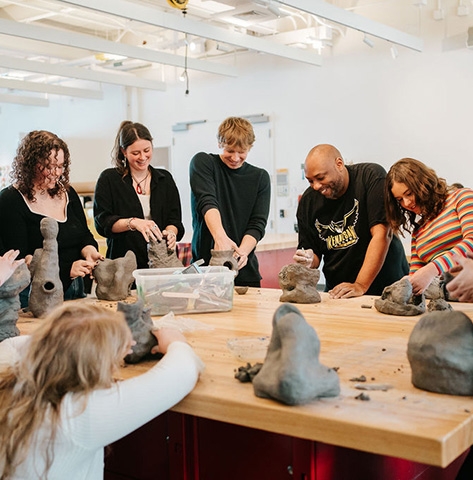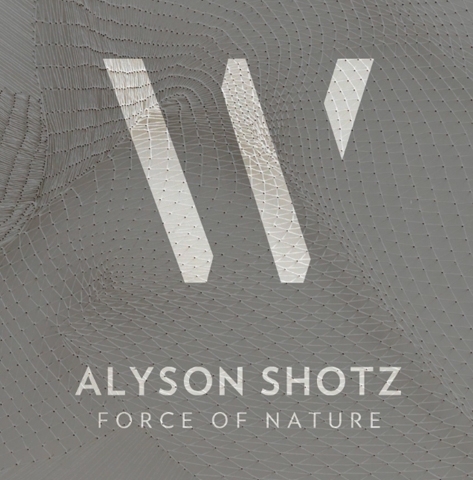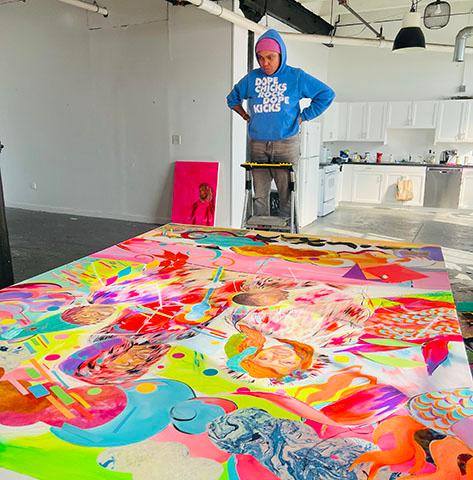Since arriving at Hamilton in 2011, I have been a frequent flyer at the Wellin Museum, consistently bringing my students to see exhibitions, use the experimental classroom space and work with photographs from the Wellin collection. Shortly after Director Tracy Adler arrived at Hamilton in 2012, I proposed curating an exhibition of contemporary photography which became In Context: The Portrait in Contemporary Photographic Practice. This large group exhibition was shown in spring 2014 and benefited from significant contributions from Hamilton students through Art 370: Curating the Archive, a course taught in fall 2013. Students worked in teams to design layouts of the exhibition, wrote catalog and wall text materials for all of the objects, and recorded podcasts about each of the artists.
So, it was not surprising that I jumped at the opportunity to co-teach a class last fall with Michael Shapiro ’71, Director Emeritus of the High Art Museum in Atlanta. Michael did his PhD in Art History at Harvard and had a long and illustrious career as a museum director. The course, Art History 310: From Collecting to Curating: American Art from 1900 to 1950, presented a history of American art from 1900-1950 examined through three related areas: 1) the development of the modern American art museum; 2) the process of collecting art, with a specific focus on Edward Root and Kevin Kennedy ‘70 as examples; and 3) the theory and process of curating an exhibition.
From the beginning this was a course about the importance of working with physical objects. In the first class, Michael and I presented works of art from our personal collections, asked students to carefully observe them, and then write about them in their first assignment. Students discussed how seeing the works in person afforded a connection to the artist’s hand and to the physicality of the work (its texture and condition) that was simply not possible with digital reproductions. Students continued this process through visits to the Wellin, Munson Williams Proctor Art Museum (MWP) in Utica, and a 3-day trip to New York City during which students met and conducted interviews with various art leaders, including museum administrators, gallery owners, auction house directors, and Hamilton alumni art collectors, including Karen and Kevin Kennedy ’70.
At the same time, students had been learning about the process of curating. How do curators go about the process of grouping objects together into a cohesive exhibition? Through course readings, interviews with curators and classroom discussion, students learned that the process of exhibition design begins with the development of a “Big Idea,” a succinct concept around which the works of an exhibition are selected and which ties everything together. The exhibition of physical objects from Karen and Kevin Kennedy ‘70’s collection currently presented in Archive Hall centers around a new generation of American artists in the first half of the 20th century who broke every rule to help invent what we know as “modern art.” Students in the course assisted with the design of the exhibition and drafted the wall texts. However, the small size of the exhibition and the relative amount of work to be done did not provide for an effective capstone experience for the course. Instead, students were asked to work in small groups, develop their own “Big Idea” and curate a virtual exhibition using objects from the Kennedy collection, the Wellin Museum and MWP. The projects that students came up with reflect their diverse creative interests:
- The development of abstraction as a formal technique in rural and urban landscape painting
- The metropolis as epicenter of Modernism
- An examination of underrepresented artists in the Modernist canon
- An exhibition of sketches and studies alongside finished work
- The rise of Abstract Expressionism out of Modernism
- The role of seasonality in Charles Burchfield’s work
- An exhibition of representations of women by male as compared to female artists
While the close study of physical objects and the development of physical exhibitions are central to a teaching museum’s mission, the creative concepts and diversity of expression explored by our students would never have been possible without the simultaneous development of their virtual exhibitions.
To learn more about the course and the work of our students, please see: https://hamiltoncs.org/CuratingAmericanArt/







